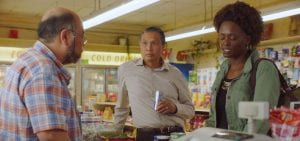Kim’s Convenience is a comedy sitcom-style drama that has been shown on Netflix since 2016. The show draws small and big events that occur around a Korean Canadian family that owns a convenience store within Toronto. Family members include Mr. and Mrs. Kim, Jung Kim, and Janet Kim. The show is focused on comic situations that occur due to the stereotypical actions that the family members take, and the results that occur due to does actions. This shows attempts to empathize with different generations of Asian immigrants living in foreign countries, through showing situations that many immigrants could agree or relate to. However, this show also perpetuates many negative Asian stereotypes as well with the intention of developing more comic exaggerated situations. Thus, some content and intentions are questionable from a moral perspective.
One of the most noticeable stereotypes that are perpetuated all throughout the show is how Mr. and Mrs. Kim has a strong Asian accent when speaking English. Both Paul Sunghyung Kima and Jean Yoon are both native level English speakers, however, because of their roles within the show, they speak so-called Konglish, a Korean compound slang for Korean and English. Although it is for the comic aspect the show is making the presumption that most first-generation immigrants will lack in English. Another stereotypical portrayal that stands out is the extremely patriarchal and stubborn attitude that Mr. Kim shows. This is a more Asian cultural stereotype regarding elderly men and the patriarchal structure of the household. Many old Asian men are portraited and thought of to be close-minded and insensitive especially toward discrimination issues such as LGBTQ rights or ethnicity rights. Within the show, not only Mr. Kim but also Mr. Chin as Chinese Canadian and Mr. Mehta an Indian Canadian is drawn to have similar attitudes. Such stereotypical portrayals of a certain marginalized community can develop biased beliefs and perspectives against that specific community. Reinforcement of such stereotypes emphasizes the relationship of one and the other between society and the Asian Canadian community in this case.
Although the intentions behind why the producers would have developed biased and exaggerated content are understandable and justified through comedy, the fact Kim’s Convenience does possibly generate biased beliefs and attitudes is unarguable. Some may say that many of the audience is mature enough to differentiate humor from reality, however, one should not underestimate that continuous exposure to biased content can develop biased beliefs and attitudes unconsciously.
Images from: https://en.wikipedia.org/wiki/Kim%27s_Convenience



